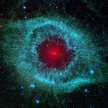Could We Be Alone in the Universe?
We may never know the answer to that very important question.

I hope you find my few short-form stories interesting. I write about the universe and life.
British spelling.
<><><>
This question is often asked. "Could we be alone in the universe?"
But unfortunately, it's not a question that can be answered at this time.
The universe is thought to hold two trillion galaxies, each made up of billions of star systems. With recent research, we can now be confident that most stars will have orbiting planets.
We can only imagine the staggering number of planets there must be out there in the unknown.
Surely our planet Earth cannot be the only one to harbour life. But what about intelligent life? Although highly unlikely, the answer could be no.
Due to the vast distances involved, we might never know for sure if we are indeed alone in the universe.
Not getting a definite answer can be frustrating for many people.
<><><>
Our short journey into space.

I can't imagine the human race getting very far from our planet.
We use miles and kilometres as a measure here on Earth, and they work well.
Space is different; we can use those units of length between the planets and moons, but if we go further out into space, they become meaningless.
The vast distances in space need to be measured using the speed of light.
Light travels at almost 300,000 kilometres per second, or 1,080 million kilometres per hour, which equates to 9.46 trillion kilometres per year.
The Sun is 8.3 light minutes from the Earth, the next star is 4.25 light years away, and the centre of our galaxy is roughly 25,000 light years away.
Now we can see objects that are over 13 billion light-years away.
The furthest any human has been from our planet is just over 1 light-second, or 400,000 kilometres.
<><><>
Do you think the sun is a big star?

If you do, then these few lines will change your mind.
When we look up at the sky, the sun seems to be the same size as the moon, but that is deceiving.
The Sun is almost 1.4 million kilometres in diameter, but there is a hypergiant star called UY Scuti that is arguably the largest star known at this time.
Imagine the Sun 1,700 times wider, or maybe this is a better way to explain the size of UY Scuti; hypothetically, if we placed that gigantic star in the same position as the Sun, how would it look from the Earth?
Well, to put it simply, you would not see it; the rocky planets Mercury, Venus, Earth, and Mars would all be inside UY Scuti, and even the distant gas giant Jupiter would also be inside that incredible star.
<><><>
Billions of years have passed.

We understand time in the context of our lifespan, which is minuscule when we consider the age of the universe.
If we look back 13.8 billion years, that is when the universe burst into existence.
13.6 billion years ago, our galaxy, the Milky Way, was forming.
Our magical planet formed just over 4.5 billion years ago, which makes it slightly younger than our local star, the Sun.
Our early ancestors, Homo sapiens, are thought to have lived in Africa roughly 300,000 years ago.
Evolution has made incredible changes to the universe and life on our planet. But of course, evolution is a process that needs plenty of time.
Our time here on Earth is too short to witness the tiny changes that are taking place.
<><><>
Will black holes ever be truly understood?

Black holes are the densest objects in the known universe.
Their density is mind-boggling. To give an example, hypothetically, the Earth would have to be crunched down to the size of a grape before it became a black hole.
It is thought that there are two trillion galaxies in the observable universe, each holding millions or billions of stars.
Our home galaxy, the Milky Way, has a black hole at its centre named Sagittarius A* with a mass of over 4 million times that of our local star, the Sun. Yes, they are amazing objects.
I mentioned the number of galaxies in the known universe; most scientists are now confident enough to say that most of them will have black holes at their centres.
The end.
<><><>
You may find my easy-to-understand stories about the universe and life interesting and educational.
If you subscribe to me for free, you will see my latest stories. Regards.
About the Creator
Unravelling the Universe
We can only imagine what our early ancestors thought as they gazed up at the night sky—were they curious about what the heavens had to hide?
Enjoyed the story? Support the Creator.
Subscribe for free to receive all their stories in your feed. You could also pledge your support or give them a one-off tip, letting them know you appreciate their work.






Comments
There are no comments for this story
Be the first to respond and start the conversation.